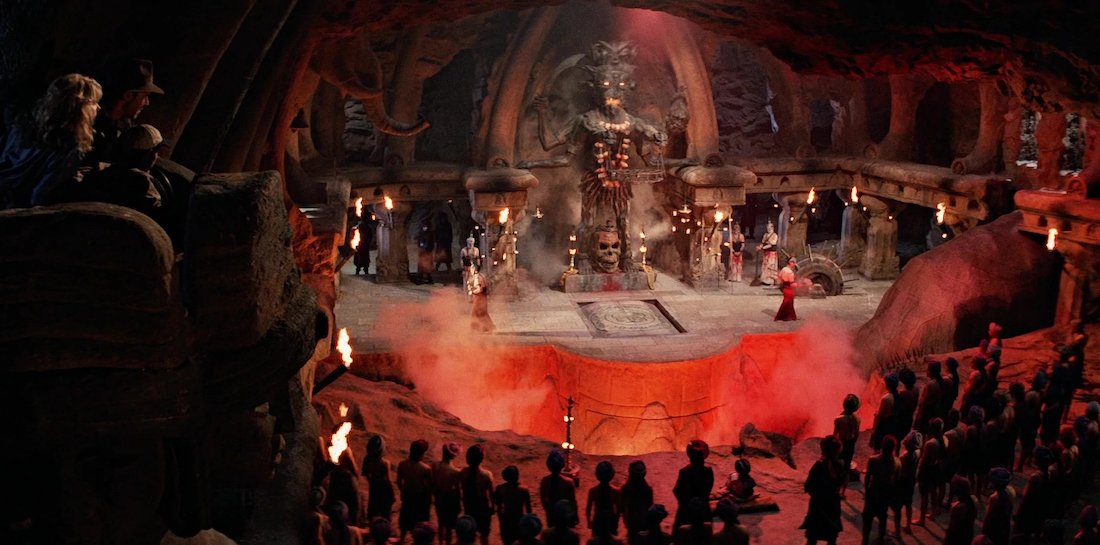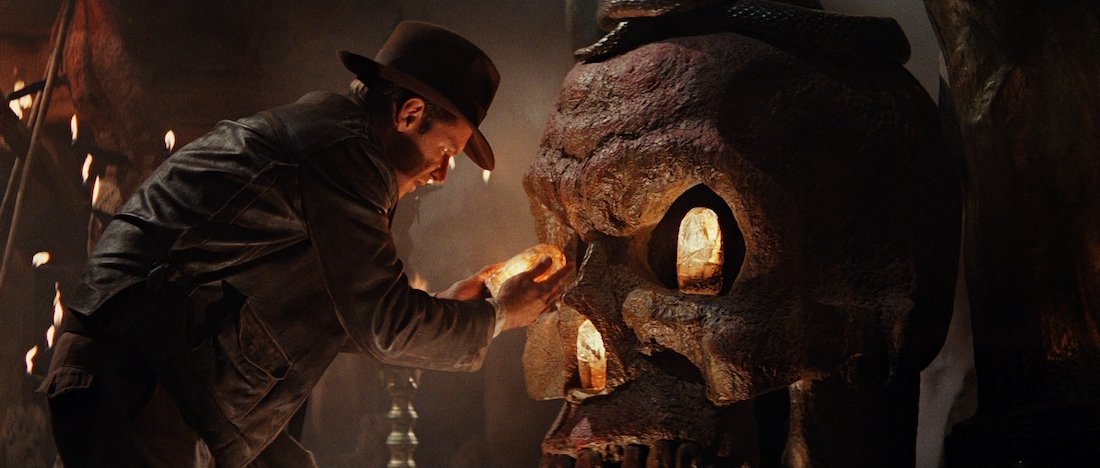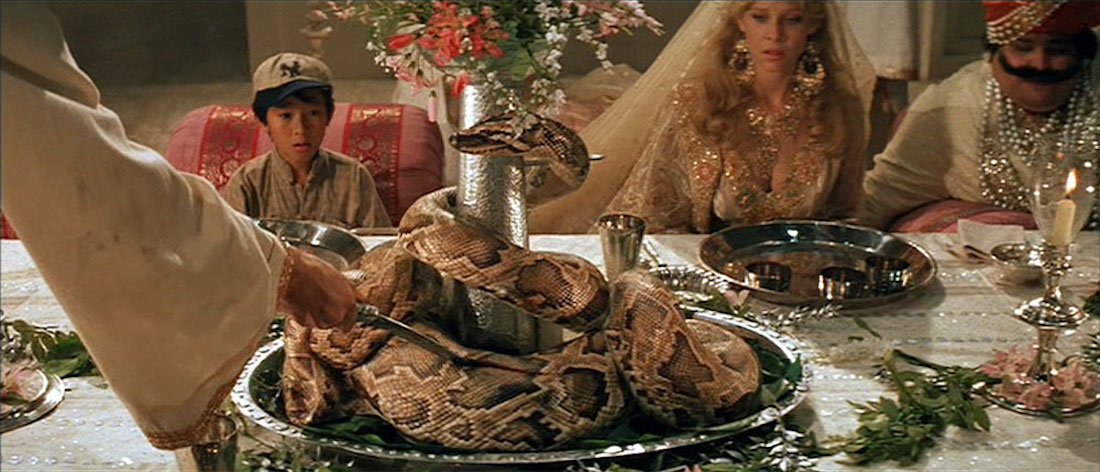INDIANA JONES AND THE TEMPLE OF DOOM (1984)
I know I'm in the minority when I say my favorite Indiana Jones adventure is TEMPLE OF DOOM (1984) directed by Steven Spielberg with story by George Lucas. I'm acutely aware that it is problematic. The Goddess Kali is unfairly depicted as a figure of evil. Hinduism is portrayed like a cult. India is illustrated as a primitive savage country. That completely unnecessary and unfunny dinner scene could have been replaced with everyone watching a beautiful dance or the men having a smoke as they discussed the stolen stones. Short Round and Willie are presented as negative stereotypes. So yeah, there are a lot of problems. Just like there are A LOT of problems in other beloved movies from the 1980s.
I'm not giving TEMPLE OF DOOM a pass for these glaring mistakes. Honestly, I am upset that I can't even say it was done in ignorance.
When the producer Robert Watts asked for permission to shoot on location at Jaipur, the Indian government asked that they change the offenses in the script first. George Lucas refused, permission was denied, and thus a model of Amer Fort was built, and Jaipur was renamed Pankot. I would hope that by now Lucas has learned from this cultural insensitivity, but in 1984, sadly this was par for the course. What we were given could have been better, but what we now have still has importance and value.
I have a complicated relationship with TEMPLE OF DOOM. It is my favorite of the franchise but, as a public historian specifically active in preserving indigenous culture and passionate about lifting up non-western narratives, I really have to center myself in the context of when this film was made.
I am also conscious of what was happening in Shanghai, India, and around the world in 1935. There is plenty that this movie got right, and Indiana Jones (Harrison Ford) is still a man we can root for.
Shanghai has a long history of being an international port city that perpetually suffers from power conflicts between China and its foreign counterparts. In 1935, westerners were a minuscule percentage of the population of Shanghai, but they had a lot of power and privilege under treaties that gave them extraterritoriality until the 1940s. You see glimpses of this globalized port briefly in the film with the white sailor and Chinese girl that get caught up in the car chase scene, and again with Dan Aykroyd working at the British Naval Base. In response to this colonization, the Chinese mob used the modern infrastructure and shipping industry to take back power under a guise of nationalism. Lao Che wanting to have remains of the Manchu Emperor Nurhaci is a small detail that tells a big story.
Nurhaci was known as a uniter of Manchurian tribes and went on to become the godfather of the Qing Dynasty. Having ownership of Nurhaci's remains gives Lao Che symbolic and religious legitimacy as the leader of the Chinese people against the foreigners in Shanghai. While this detail contributes nothing to Dr. Jones's plot in India, it is a glimpse into the privilege Indiana Jones had as he navigated around the world. It wasn't merely skill and luck of the draw that kept Indiana Jones alive in all these outlandish situations. It helped that he was a white male westerner with a highly regarded education background and reputation that gave him power. In 1935, Dr. Jones could move much more freely around the world and network more than most. Without this, he wouldn't have been so warmly accepted at the Pankot Palace or been able to get on a plane out of China (even as it was Lao Che). If we are thinking ahead past the end of the movie, there is no doubt he would have been able to get out of India easily with the help of the British. Privilege is power, and it indirectly saves Dr. Jones' ass often.
The Hindu mythos of the five Sankara Stones does check out in a way. In the movie, Shiva passed on these five stones of power to combat evil. Beyond the folklore, Hindu people use stone amulets called lingam to symbolize Shiva's power to carry with them. The film makes it clear that the village's success is directly tied to the stone. This is a McGuffin the audience can get behind. It is unfortunate that it was also suggested these stones—meant to aid in bringing goodness—were also depicted to fuel the power of evil. Ripping out beating hearts and kidnapping children to make them slaves is, after all, pretty freaking evil. There is another sad story that we don't speak of often. Mola Ram (Amrish Puri) seeks to gain this power for revenge against and independence from the British. While it does nothing to lessen the atrocity of his crimes, it does remind us that violence begets violence. This film succeeds in speaking on colonization both in its accurate representation of the governance, but also how it reflects the racist nature of colonization. In order to justify colonization, you have to convince people the oppressed party is less than human or primitive.
I don't know why George Lucas felt the trope of eating exotic animals was necessary to the plot. But it illustrates how the pulp adventure comics this movie emulates were based on the same racist propaganda to justify colonization. What was supposed to be humorous and fun instead became an example of how insidious and egregious misinformation can be when used to oppress others. In a way, TEMPLE OF DOOM refusing to correct this before production only furthers the evidence that colonization even after it has ended, causes long lasting world changing effects.
In all this darkness, we still have our hero. Indiana Jones is not a flawless character, but he is a lovable one. He is someone we can relate to because he wants fame and fortune. He wants the easy way out. Yet, when it comes to doing the right thing, he will always deliver. The elation I felt when he says, “We're getting out of here...All of us.” is not something I get from movies often.
I have so much faith in that character. That's the most important part of all this. In our journeys, we either take the opportunity to learn and grow as people—or we become zombified Nazis/eaten by crocodiles.
TEMPLE OF DOOM has a lot of problems that we are now more open to addressing in today's climate. These are things we can learn from moving forward.
Yet at the end of the day, TEMPLE OF DOOM is a damn good movie. Arguably one of the best adventure films of all time. It's so good that even where it fails, it fails upward to prove its own point. Governments often do heinous things in the name of power. It's up to individual people to fight back in the name of love.







